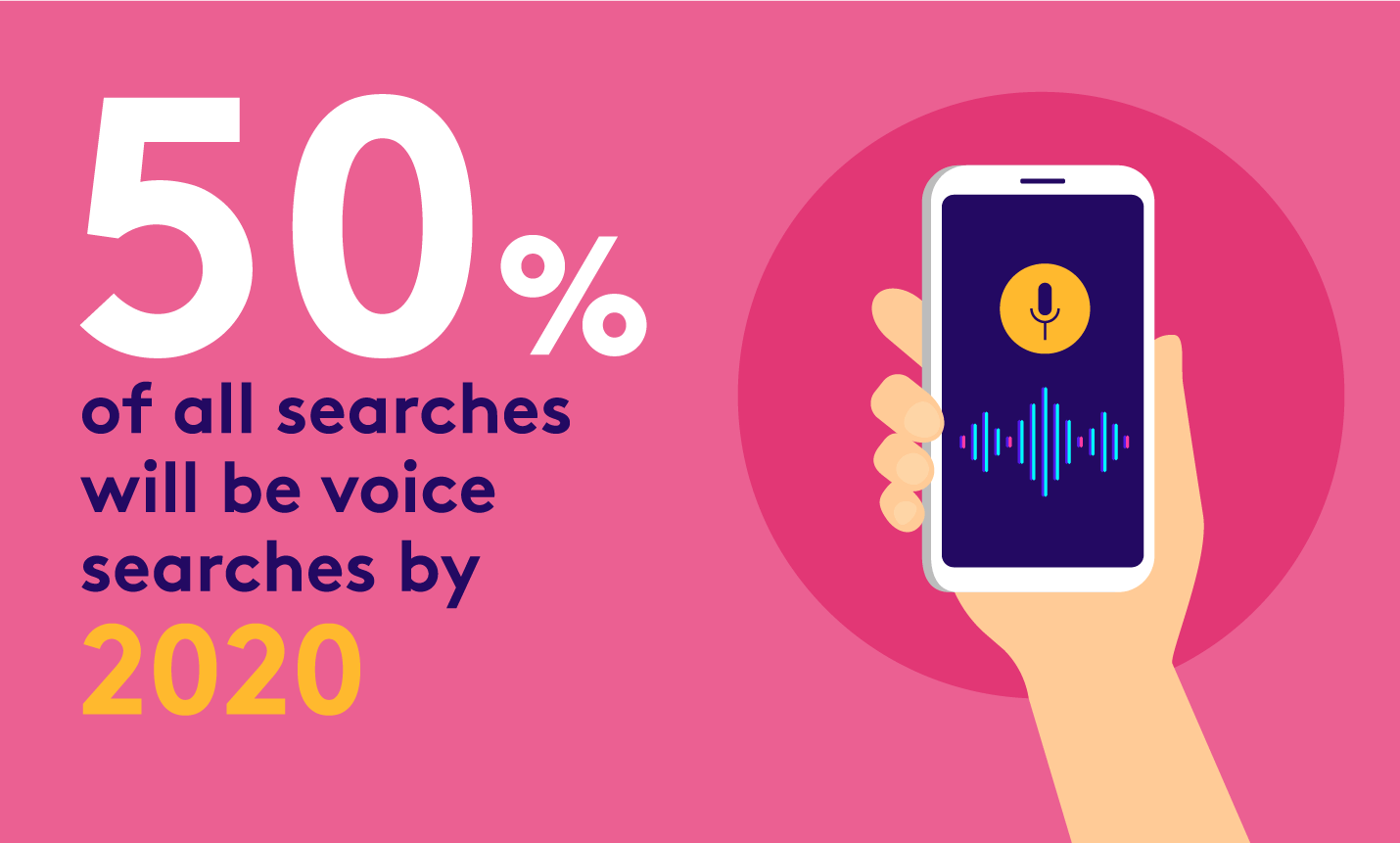There’s a comedic scene in the 1986 film Star Trek IV: The Voyage Home where Scotty tries to interact with a 1980’s-era computer by saying “Hello, computer.” Of course, it doesn’t work. Voice commands would need another 30 years before becoming reality.
But that scene would later inspire Jeff Bezos, a lifelong Star Trek fan, to build Amazon’s digital voice assistant, Echo. In fact, you can wake up Echo by doing like Scotty and saying “Computer!” 01
Today, you can take your pick of voice command app: Siri, Alexa, Cortana, and Google Assistant. You can choose to tell apps like Siri to navigate to a destination, play some music, or even launch an app.
The Two Functions of Voice Technology
There are two main things that a voice-ready app does: the text-to-speech functionality (AKA speech synthesizer) allows a device to read stuff to you, and the speech recognition technology allows your device to understand what you’re saying to it.
Text-To-Speech (TTS) is basically the machine communicating with the user. It’s the technology behind Siri’s or Alexa’s robotic voice when you ask that it read back your SMS messages, or the weather outlook. It quite literally takes any text and passes it through a speech synthesizer that can then read it out to you in a facsimile of a human voice.
Speech recognition is the user communicating with the machine. This functionality allows your devices to listen or record your voice via microphone so it can analyze what you say, look for familiar commands, and execute your orders like a good little robot.
Why This is the Perfect Time for Virtual Assistant Apps
Voice recognition app technology has advanced quite a ways since the 2011 launch of Siri to the mixed reviews of users and critics alike, all the way to the launch of Amazon’s Echo and Google Home in 2017. Suddenly there is more widespread acceptance of voice search thanks to the efficiency of AI and neural networks.
Why has it gotten so entrenched in our apps and in our daily lives? Several factors are at play here:
Speech is the Most Natural Interface
First, voice comes naturally to us. With all the focus on mindfulness and productivity, a “return” to a more natural way to do computing fits the current climate.
Speech is one of the first interaction methods we learn as humans. There is only a major learning curve at the start (as a toddler) but once out of diapers, we’re experts at vocalizing our demands to parents, peers, and now, the personal assistant app.
AI Has Grown Up
Second, artificial intelligence, machine learning, and neural networks have come of age and are now able to help machines parse our sentences and comprehend every human accent, every word we say to them. This capability to understand leads to more efficient interaction between our voices and the devices we talk to.
There are more than 2 billion monthly active users of Android around the globe.02
That gives Google a treasure trove of voice data that is being used to improve the accuracy of its apps in understanding verbal commands and voice search. As a personal assistant for Android, the Google app is one of the top virtual assistant apps around because it has so much voice data to draw insight from.
Speech Enhances the Mobile Experience
Finally, speech is the perfect interface for mobile devices. Consider how busy the average adult is. We’re on the go all the time, with devices that are steadily increasing in screen size but which never fully allow for a comfortable typing experience.
Voice commands allow us to access our content and our apps while moving around, while on the road, or when our hands are full (literally).
The Benefits of the Voice Command App
Voice search is a huge functionality that everyone is coming to expect, especially from IoT (Internet of Things) related apps. Why even bother typing when you can fire up voice search in a personal assistant app when you’re busy cooking?
Speed of communication is another benefit. Anyone who has dictated a text message while in the car knows this is true. And if you’ve used the built-in dictation functionality in Google Docs you know how easy it is to type an entire paragraph of text without even touching the keyboard.
Examples of How Voice is Changing Marketing
For mobile marketers, voice search is slowly and steadily changing the game. Consider these stats:
20% of all searches across the Google app and Android devices are currently voice, according to Google.03
50% of all searches will be voice searches by 2020, according to comScore.04
By 2020, 30% of all web browsing will be done without a screen, according to Gartner.05
If marketers are to be effective in the age of voice, they have to start optimizing their content with these virtual assistant apps in mind.
Take a look at some of these examples.
Amazon Echo allows you to ask Alexa for an Uber ride. You can then receive voice updates in real time on where your Uber ride is. You can even cancel via voice command.
iOS 12’s recent release has brought in a deluge of apps that now support the Siri Shortcuts suggestions feature.06 This means there are many more iOS apps that you can use voice commands with, including:
- Twitter: create a new tweet, check what’s happening
- Kayak: check trip information and flight confirmation codes
- Tripit: ask for info on upcoming travel plans
- Evernote: view a note/notebook/saved search/space, create a new camera or audio note, copy a note link to clipboard, and more
- Bear: create new notes, search notes, create custom commands for the Bear note-taking app
- Tile: locate an item that has a Tile device on it
- Toggl: start or stop your work timer
The Impact of Voice on Marketing
Longer questions instead of phrases/keywords
People aren’t just searching using phrases or keywords typed into the search box. They’re already searching using complete sentences, starting questions off with: who, what, how, when, where.
And those questions will help you figure out the users’ intent. For example: asking “How do I buy a Toyota van?” doesn’t indicate as much purchase intent as “Where do I buy a Toyota van?”
Voice search will more likely be local
Think about it: where do you usually ask your virtual assistant “Find a gas station near me?” When you’re in the car ready to buy gas at the nearest location. When you need a local result that is on your path or in your vicinity.
Increase in expense and competition
The increased competition to rise to the top of SERPs will likely make it more expensive and more difficult for marketers to rank for their keyword questions.
Tips on Marketing with Voice in Mind
So what can you, as a marketer, do about all this?
Ensure you have a mobile optimized website
If you don’t have one now, you’re already lagging behind. People who are searching using their voice are, more often than not, using their mobile devices. Not having a mobile-optimized site means people are clicking away from your content because their user experience is awful.
Write content as if you were speaking!
Write as if you were speaking. This is, after all, a conversation with a user – even if it’s non-linear. Your marketing content is anticipating a user query.
In lieu of hyping your product’s features, simply and concisely answer the questions that your users are asking. They are typically verbalizing short questions and expect short, direct answers. Avoid jargon or legalese unless you want to look unapproachable.
Content in this current season of voice search is no longer just about keywords. It’s also about semantic search and building on the context that led a user to ask a question. What are they experiencing while asking this? If you can grasp the background context, your marketing content can more accurately fulfill their needs. Which leads us to intent.
Write content in a Q&A format
Because people are asking full questions, you need to write Q&A or FAQ-style content. Including the question in your site means you’re optimizing to be found for that question.
Us the 5 W’s to structure your FAQ content. Answer questions that start with: who, what why, where, when, (even how).
Understand the intent
Before you can create content that answers user pain points, you must understand the intent that led to their search.
People will be asking questions in a number of different ways. If you comprehend their intent at every level (from “merely interested” to “ready to buy”), you can move beyond more obvious keywords to include the long tail keyword phrases that may lead to conversions.
Get listed on local properties
Remember that many voice searches are local. If you aren’t showing up on sites like Google Local or Yelp, you’re missing a great opportunity for new business.
Organize data with Schema markup
If your web content and your data is structured efficiently, this tells search engines what info to surface. Google can more readily display the answers on its cards.
Using Schema.org structured data and Schema markup can help search engines crawl your content better. This results in much more appealing rich snippets displayed beneath your page title in the SERPs. 07
Including Voice Commands in Your App
Apart from optimizing your content to be found, consider including voice commands in your app. As mobile users are still getting used to navigating or activating functions using voice, now is the time to make your app voice compatible.
Here are some ideas:
For Travel Apps
- Search via voice. Make it easy to use voice commands to search for places to visit or sights to see in a travel destination.
- Set alarms/reminders. Sure, you can set a system-wide alarm from your device, but why not use your voice to activate a reminder within your travel app? For example: set a reminder to buy tickets, or set a wake-up alarm so you don’t miss your flight.
- Take photos/videos. Why not integrate a way to take photos or videos by voice from your app as you travel? Either as a way to document your journey, or as a way to save receipts or expenses.
For Media/ Entertainment Apps
- Start/stop/pause/rewind your media. Why not make it easier for users to control their media without having to touch the screen? Include voice commands for start, stop, pause, rewind or go forward 10 seconds.
- Take notes by voice. How about including a way to take notes while viewing or listening to media? This would be beneficial to those consuming audiobooks or viewing lectures or webinars.
Conclusion
As we progress into a future where we may not need screens to do our computing, it’s in our best interests as mobile marketers to pave the way by optimizing our content and our apps right now for voice search and voice commands.

Metrics That Matter for Growth: A Handbook for Mobile Marketers
Shivkumar M 
Head Product Launches, Adoption, & Evangelism.Expert in cross channel marketing strategies & platforms.
Free Customer Engagement Guides
Join our newsletter for actionable tips and proven strategies to grow your business and engage your customers.















































